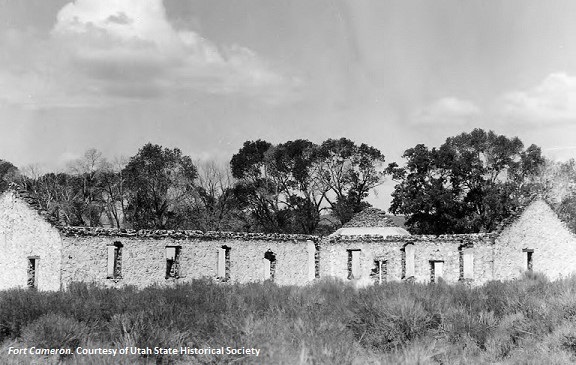Dublin Core
Title
Description
Two early US Army installations in Utah were built to protect white settlers from the perceived threat of Indian attacks.
In 1873, President Ulysses S. Grant formally authorized the creation of a permanent US Army garrison near Beaver named Fort Cameron. Built to protect white settlers from the perceived threat of Indian attacks, the fort was laid out in a rectangular shape with walls enclosing barracks, a hospital, parade grounds, a bakery, and stables, with the local mountains supplying the black lava rock for the buildings and exterior walls. Once the fort was finished, however, the soldiers stationed there had little to keep them occupied, besides guarding John D. Lee who had been jailed at the fort for a brief time in advance of his trial for participating in the Mountain Meadows Massacre. The soldiers and the mostly Mormon townspeople didn’t always get along, but relations between the two groups were relatively warm until the post closed in 1883 when the arrival of the railroad made it obsolete. More than a decade later, the LDS Church, which had purchased the property from the federal government, turned the fort into a southern branch of the Brigham Young Academy.
Equally important on Utah’s military frontier was Fort Thornburgh, which was first established in 1881 near present-day Ouray and then moved to the mouth of Ashley Creek, near present-day Vernal, less than a year later. Following what some have called the Meeker Massacre, where Ute Indians killed a handful of whites near Colorado’s White River Indian Agency, the Uncompahgre and White River Utes were forced to trek from their lands in Colorado to Utah’s Uintah Basin. Believing that an army installation would be needed to keep the Utes quiet, the Secretary of War ordered the creation of Fort Thornburgh. When the fort was finished a detachment of thirty men was left to garrison the fort. When Congress wouldn’t approve new funds to improve the fort, it was abandoned and superseded by Fort Duchesne as the symbol of American military might in the Uintah Basin.
Creator
Source
Image: Fort Cameron. Ruins of Fort Cameron at Beaver. Courtesy of Utah State Historical Society.
_______________
See Thomas G. Alexander and Leonard K. Arrington, “The Utah Military Frontier, 1872-1912: Forts Cameron, Thornburgh, and Duchesne,” Utah Historical Quarterly 32 (Fall 1964): 330-354. Also see David Schirer’s entry on Fort Thornburgh in the online Utah History Encyclopedia.

